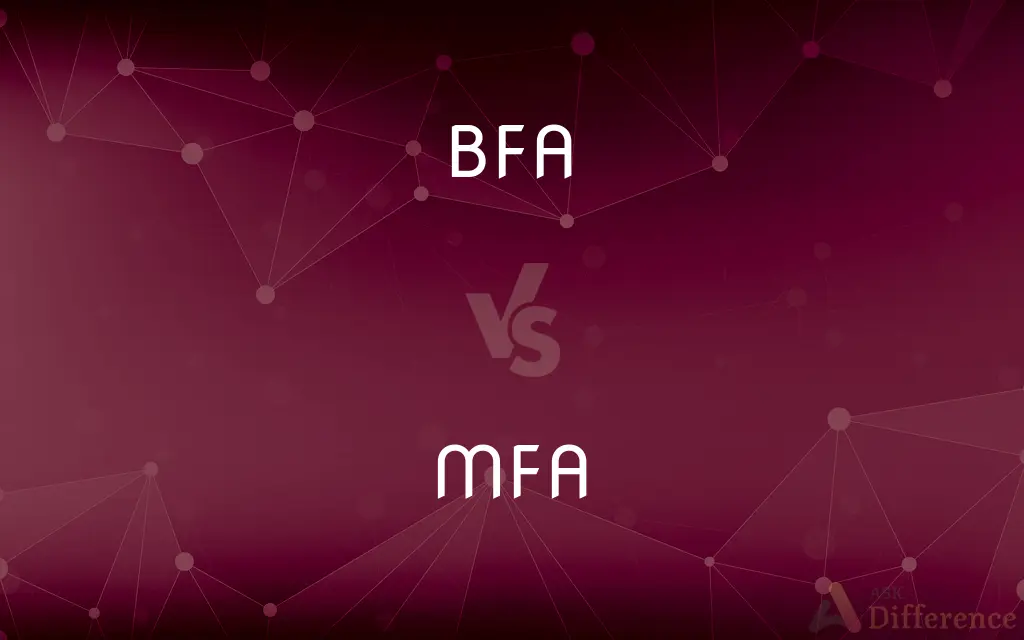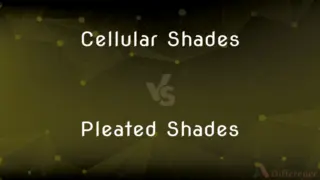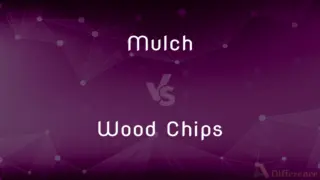BFA vs. MFA — What's the Difference?
By Tayyaba Rehman & Maham Liaqat — Published on March 1, 2024
A BFA (Bachelor of Fine Arts) focuses on intensive art and design studies with less emphasis on liberal arts, while an MFA (Master of Fine Arts) is a graduate-level degree offering advanced professional training in creative disciplines.

Difference Between BFA and MFA
Table of Contents
ADVERTISEMENT
Key Differences
The BFA is an undergraduate degree designed for students to receive a deep immersion in their chosen art or design discipline, often involving hands-on studio work and foundational courses related to their field. It typically takes four years to complete and is aimed at developing technical skills and artistic expression.
The MFA, on the other hand, is a graduate-level degree that takes about two to three years to complete. It is considered the highest degree for creative disciplines, emphasizing professional development, advanced techniques, and theoretical understanding. MFA programs often require a thesis or final project that demonstrates mastery of the subject.
BFAs focus on the acquisition and refinement of creative skills, whereas MFAs aim to elevate these skills to a professional level, offering opportunities for critical feedback, networking, and in-depth study of one's craft. The transition from a BFA to an MFA marks a shift from student to professional artist or designer.
One key difference is the career paths graduates might pursue. BFA holders often enter directly into creative roles, such as graphic designers, artists, or performers. MFA graduates, while also pursuing these paths, are additionally qualified for academic careers, teaching at the college level, or leading advanced workshops in their field.
The choice between a BFA and an MFA depends on the individual’s career goals and the depth of training they seek. While a BFA provides a solid foundation in a creative discipline, an MFA offers the chance to refine these skills further and explore complex concepts, preparing graduates for leadership roles in their field.
ADVERTISEMENT
Comparison Chart
Level
Undergraduate
Graduate
Focus
Intensive study in art or design discipline, with less emphasis on liberal arts
Advanced professional training, theoretical understanding, and practice
Duration
Typically 4 years
2-3 years
Career Paths
Entry-level creative roles, artists, designers
Professional artists, designers, educators at the college level
Final Requirement
Senior project or portfolio
Thesis or final project demonstrating mastery of the subject
Compare with Definitions
BFA
It prepares students for professional careers in art and design.
After his BFA, he became a successful commercial photographer.
MFA
It is considered the highest degree in creative disciplines.
With her MFA in hand, she qualified for university-level teaching positions.
BFA
Focuses less on liberal arts compared to traditional degrees.
Her BFA curriculum had fewer general education requirements, allowing more studio time.
MFA
An MFA is a terminal graduate degree emphasizing creative practice and advanced study in the arts.
He pursued an MFA in Creative Writing to focus on his novel.
BFA
A BFA is an undergraduate degree focusing on practical and studio-based work in the arts.
She earned her BFA in Sculpture from the Rhode Island School of Design.
MFA
Offers opportunities for professional development and networking.
His MFA program included workshops with renowned artists.
BFA
Requires a significant amount of coursework in the chosen discipline.
His BFA program required 60% of courses in studio art.
MFA
MFA graduates are prepared for careers in academia and advanced artistic practice.
Post-MFA, she landed a professorship in the Fine Arts department.
BFA
BFA programs offer in-depth studies in specific art forms.
She chose a BFA in Painting to refine her artistic techniques.
MFA
MFA programs often culminate in a thesis or comprehensive project.
For her MFA thesis, she curated a gallery exhibition of her work.
MFA
A master's degree in fine arts.
Common Curiosities
How long does it take to complete an MFA?
It typically takes 2-3 years to complete an MFA program.
Can I apply for an MFA without a BFA?
Yes, applicants with a strong portfolio and a bachelor's degree in any field can apply for an MFA program.
Is an MFA required to be a professional artist?
While not required, an MFA can provide advanced skills, networking opportunities, and qualifications for teaching at the college level.
What careers can I pursue with a BFA?
Graduates can pursue various creative roles, such as graphic designers, artists, illustrators, or performers.
Is financial aid available for MFA students?
Many MFA programs offer financial aid, including teaching assistantships, scholarships, and fellowships.
Can I work while completing my MFA?
Yes, many students work part-time or engage in professional projects while completing their MFA, though the workload is intensive.
What is the advantage of getting a BFA over a BA in art?
A BFA offers more focused and intensive training in the arts, with more studio courses and less emphasis on liberal arts compared to a BA.
What is the main difference between a BFA and an MFA?
The main difference is the level of study: a BFA is an undergraduate degree focusing on developing artistic skills, while an MFA is a graduate degree aimed at professional practice and theoretical understanding.
Do MFA programs require a thesis?
Yes, most MFA programs require a thesis or final project that demonstrates mastery of the subject.
What careers can I pursue with an MFA?
Beyond the careers available to BFA graduates, MFA holders can also qualify for higher-level positions, including academic roles and leadership positions in arts organizations.
Share Your Discovery

Previous Comparison
Cellular Shades vs. Pleated Shades
Next Comparison
Mulch vs. Wood ChipsAuthor Spotlight
Written by
Tayyaba RehmanTayyaba Rehman is a distinguished writer, currently serving as a primary contributor to askdifference.com. As a researcher in semantics and etymology, Tayyaba's passion for the complexity of languages and their distinctions has found a perfect home on the platform. Tayyaba delves into the intricacies of language, distinguishing between commonly confused words and phrases, thereby providing clarity for readers worldwide.
Co-written by
Maham Liaqat















































